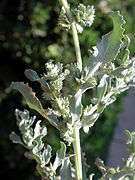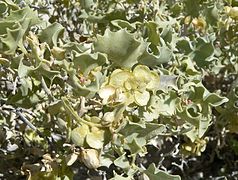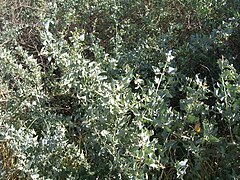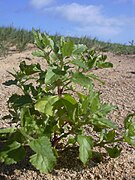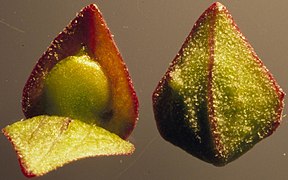
Atriplex
| Atriplex | |
|---|---|
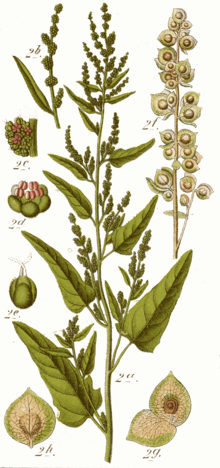
| |
|
Garden orache (Atriplex hortensis) From Sturm & Sturm (1796): Deutschlands Flora in Abbildungen. | |
|
Scientific classification | |
| Kingdom: | Plantae |
| Clade: | Tracheophytes |
| Clade: | Angiosperms |
| Clade: | Eudicots |
| Order: | Caryophyllales |
| Family: | Amaranthaceae |
| Subfamily: | Chenopodioideae |
| Tribe: | Atripliceae |
| Genus: |
Atriplex L. |
| Type species | |
|
Atriplex hortensis L.
| |
| Species | |
| Synonyms | |
|
List
| |
Atriplex (/ˈætrɪplɛks/) is a plant genus of about 250 species, known by the common names of saltbush and orache (/ˈɒrɪtʃ, -ətʃ/; also spelled orach). It belongs to the subfamily Chenopodioideae of the family Amaranthaceae s.l.. The genus is quite variable and widely distributed. It includes many desert and seashore plants and halophytes, as well as plants of moist environments. The generic name originated in Latin and was applied by Pliny the Elder to the edible oraches. The name saltbush derives from the fact that the plants retain salt in their leaves; they are able to grow in areas affected by soil salination.
Description
Species of plants in genus Atriplex are annual or perennial herbs, subshrubs, or shrubs. The plants are often covered with bladderlike hairs, that later collapse and form a silvery, scurfy or mealy surface, rarely with elongate trichomes. The leaves are arranged alternately along the branches, rarely in opposite pairs, either sessile or on a petiole, and are sometimes deciduous. The leaf blade is variably shaped and may be entire, tooth or lobed.
The flowers are borne in leaf axils or on the ends of branches, in spikes or spike-like panicles . The flowers are unisexual, some species monoecious, others dioecious. Male flowers have 3-5 perianth lobes and 3-5 stamens. Female flowers are usually lacking a perianth, but are enclosed by 2 leaf-like bracteoles, have a short style and 2 stigmas.
After flowering, the bracteoles sometimes enlarge, thicken or become appendaged, enclosing the fruit but without adhering to it.
The chromosome base number is x = 9, except for Atriplex lanfrancoi, which is x=10.
A few Atriplex species are C3-plants, but most species are C4-plants, with a characteristic leaf anatomy, known as kranz anatomy.
Atriplex patula, female flower with bracteoles and ovule
Taxonomy
The genus Atriplex was first formally described in 1753 by Carl Linnaeus in Species Plantarum. The genus name was used by Pliny for orach, or mountain spinach (A. hortensis).
Phylogeny
The genus evolved in Middle Miocene, the C4-photosynthesis pathway developed about 14.1–10.9 million years ago (mya), when the climate became increasingly dry. The genus diversified rapidly and spread over the continents. The C4Atriplex colonized North America probably from Eurasia during the Middle/Late Miocene, about 9.8–8.8 mya, and later spread to South America. Australia was colonized twice by two C4 lineages, one from Eurasia or America about 9.8–7.8 mya, and one from Central Asia about 6.3–4.8 mya. The last lineage diversified rapidly, and became the ancestor of most Australian Atriplex species.
Systematics
The type species (lectotype) is Atriplex hortensis. The name is derived from Ancient Greek ἀτράφαξυς (atraphaxys), "orach", itself a Pre-Greek substrate loanword.
Atriplex is an extremely species-rich genus and comprises about 250-300 species, with new species still being discovered. An example includes Atriplex yeelirrie, formally described in 2015.
Traditional taxonomy of Atripliceae based on morphological features has been controversial. Molecular studies have found that many genera are not true clades. One such study found that Atripliceae could be divided into two main clades, Archiatriplex, with a few, scattered species, and the larger Atriplex clade, which is highly diverse and found around the world. After phylogenetic research, Kadereit et al. (2010) excluded Halimione as a distinct sister genus. The remaining Atriplex species were grouped into several clades.
The following is a cladogram with estimated divergence times for the tribe Atripliceae. To infer the phylogeny, an ITS matrix composed of spacer ITS-1, the 5.8S subunit, and spacer ITS-2 were amplified and sequenced for each specimen. Not all species in the genus Atriplex are presented in the cladogram (based on page 7 of ). This work suggested that the Americas were colonised by C4 Atriplex from Eurasia or Australia. Furthermore, that in the Americas Atriplex first appeared in South America, where two lineages underwent in situ diversification and evolved sympatrically. North America was then colonised by Atriplex from South America, then one lineage later moved back to South America.
|
Cladogram of estimated divergences within the genus Atriplex
| ||||||||||||||||||||||||||||||||||||||||||||||||||||||||||||||||||||||||||||||||||||||||||||||||||||||||||||||||||||||||||||||||||||||||||||||||||||||||||||||||||||||||||||||||||||||||||||||||||||||||||||||||||||||||||||||||||||||||||||||||||||||||||||||||||||||||||||||||||||||||||||||||||||||||||||||||||||||||||||||||||||||||||||||||||||||||||||||||||||||||||||||||||||||||||||||||||||||||||||||||||||||||||||||||||||||||||||||||||||||||||||||||||||||||||||||||||||||||||||||||
|---|---|---|---|---|---|---|---|---|---|---|---|---|---|---|---|---|---|---|---|---|---|---|---|---|---|---|---|---|---|---|---|---|---|---|---|---|---|---|---|---|---|---|---|---|---|---|---|---|---|---|---|---|---|---|---|---|---|---|---|---|---|---|---|---|---|---|---|---|---|---|---|---|---|---|---|---|---|---|---|---|---|---|---|---|---|---|---|---|---|---|---|---|---|---|---|---|---|---|---|---|---|---|---|---|---|---|---|---|---|---|---|---|---|---|---|---|---|---|---|---|---|---|---|---|---|---|---|---|---|---|---|---|---|---|---|---|---|---|---|---|---|---|---|---|---|---|---|---|---|---|---|---|---|---|---|---|---|---|---|---|---|---|---|---|---|---|---|---|---|---|---|---|---|---|---|---|---|---|---|---|---|---|---|---|---|---|---|---|---|---|---|---|---|---|---|---|---|---|---|---|---|---|---|---|---|---|---|---|---|---|---|---|---|---|---|---|---|---|---|---|---|---|---|---|---|---|---|---|---|---|---|---|---|---|---|---|---|---|---|---|---|---|---|---|---|---|---|---|---|---|---|---|---|---|---|---|---|---|---|---|---|---|---|---|---|---|---|---|---|---|---|---|---|---|---|---|---|---|---|---|---|---|---|---|---|---|---|---|---|---|---|---|---|---|---|---|---|---|---|---|---|---|---|---|---|---|---|---|---|---|---|---|---|---|---|---|---|---|---|---|---|---|---|---|---|---|---|---|---|---|---|---|---|---|---|---|---|---|---|---|---|---|---|---|---|---|---|---|---|---|---|---|---|---|---|---|---|---|---|---|---|---|---|---|---|---|---|---|---|---|---|---|---|---|---|---|---|---|---|---|---|---|---|---|---|---|---|---|---|---|---|---|---|---|---|---|---|---|---|---|---|---|---|---|---|---|---|---|---|---|---|---|---|---|---|---|---|---|---|---|---|---|---|---|---|---|---|---|---|---|---|---|---|---|---|---|---|---|---|---|---|---|---|---|---|---|---|---|---|---|---|---|---|---|---|---|---|---|---|---|---|---|---|---|---|---|---|---|---|---|---|---|---|---|---|---|---|---|---|---|
|
|
Clades of Atriplex
|
|---|
|
Distribution and habitat
The genus Atriplex is distributed nearly worldwide from subtropical to temperate and to subarctic regions. Most species-rich are Australia, North America, South America and Eurasia. Many species are halophytes and are adapted to dry environments with salty soils.
Ecology
Atriplex species are used as food plants by the larvae of some Lepidoptera species; see the list of Lepidoptera which feed on Atriplex. They are also sometimes consumed by camels.For spiders such as Phidippus californicus and other arthropods, saltbush plants offer opportunities to hide and hunt in habitat that is otherwise often quite barren.
It has been proposed that genus Atriplex was a main food source in the diet of the extinct giant kangaroo Procoptodon goliah. Stable isotopic data suggested that their diet consisted of plants that used the C4 photosynthetic pathway, and due to their semi-arid distribution, chenopod saltbushes were likely responsible.
Uses
The favored species for human consumption is now usually garden orache (A. hortensis), but many species are edible and the use of Atriplex as food is known since at least the late Epipaleolithic (Mesolithic).
Common orache (A. patula) is attested as an archaeophyte in northern Europe, and the Ertebølle culture is presumed to have used it as a food. Its seed has been found among apparent evidence of cereal preparation and cooking at Late Iron Age villages in Britain. In the biblical Book of Job, mallûaḥ (מַלּ֣וּחַ, probably Mediterranean saltbush, A. halimus, the major culinary saltbush in the region) is mentioned as food eaten by social outcasts (Job 30:4). Grey saltbush (A. cinerea) has been used as bushfood in Australia since prehistoric times. Chamiso (A. canescens) and shadscale (A. confertifolia) were eaten by Native Americans, and spearscale (A. hastata) was a food in rural Eurasia.
Studies on Atriplex species demonstrated their potential use in agriculture. Meat from sheep which have grazed on saltbush has surprisingly high levels of vitamin E, is leaner and more hydrated than regular lamb and has consumer appeal equal to grain-fed lamb. The vitamin E levels could have animal health benefits while extending the shelf-life and maintaining the fresh red colour of saltbush lamb. This effect has been demonstrated for old man saltbush (A. nummularia) and river saltbush (A. amnicola). For reasons unknown, sheep seem to prefer the more fibrous, less nutritious river saltbush.
A study on A. nummularia discovered the species have a nitrogen content of 2.5–3.5%, and could potentially be used as a protein supplement for grazing if palatable. A subsequent study allowed sheep and goats to voluntarily feed on Atriplex halimus and aimed to determine if the saltbush was palatable, and if so, did it provide enough nutrients to supplement the diet of these animals. In this study they determined when goats and sheep are given as much A. halimus as they like, they do obtain enough nutrients to supplement their diet – unless the animal requirements are higher during pregnancy and milk production.
Saltbushes are also used as an ornamental plant in landscaping and can be used to prevent soil erosion in coastal areas. Old man saltbush (Atriplex nummularia) has also been successfully used to rehabilitate old mining sites around Lightning Ridge (Australia).
See also
- Barbara Hulme, producer of Atriplex hybrids
- Davidson, Alan (1999): Orach. In: Oxford Companion to Food: 556. ISBN 0-19-211579-0
- Everitt, J.H.; Lonard, R.L.; Little, C.R. (2007). Weeds in South Texas and Northern Mexico. Lubbock: Texas Tech University Press. ISBN 0-89672-614-2
